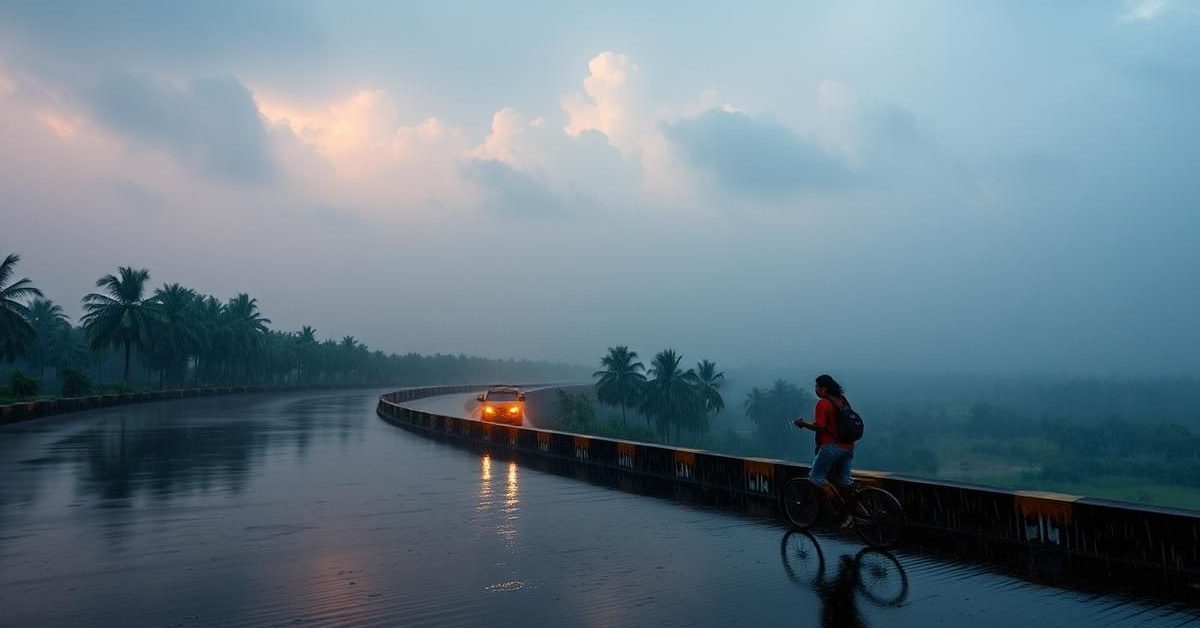Navigating the Monsoon’s Murmur: How IMD Became India’s Unseen Shield
Every year, as the scorching Indian summer gives way to the first drops of the southwest monsoon, a collective sigh of relief sweeps across the nation. Yet, for millions, this isn’t just about the changing season; it’s about life, livelihoods, and critical decisions. Behind these moments of anticipation and preparedness stands the India Meteorological Department (IMD), a venerable institution whose daily forecasts, like the recent yellow alert issued for Delhi-NCR, shape the very rhythm of our lives.
As this pivotal agency, responsible for everything from precise weather predictions to vital seismic alerts, celebrates its 150th anniversary, it’s a profound moment to reflect. The IMD’s evolution over a century and a half isn’t merely a tale of scientific progress; it’s a living chronicle of India’s shifting priorities in governance, disaster management, and its relentless pursuit of a scientifically advanced, resilient future.
From Calamity to Clarity: The Genesis of IMD’s Crucial Role
The origins of the IMD, founded on January 15, 1875, are deeply rooted in tragedy. Devastating natural disasters, such as the catastrophic tropical cyclone that struck Calcutta (now Kolkata) in 1864 and the widespread famines of 1866 and 1871, directly linked to monsoon failures, spurred a critical realization. The then-Government of India understood the desperate need for a unified, robust forecasting mechanism to avert future humanitarian crises.
This dire necessity led to the consolidation of existing meteorological efforts, bringing together observatories from Calcutta, Madras (now Chennai), and Colaba under one centralized authority. What began as a nascent effort to predict the monsoon and issue basic cyclone warnings has, especially since India gained independence, blossomed into an expansive and indispensable national service. Today, the IMD operates under the Ministry of Earth Sciences (MoES), a testament to its broad and integrated scientific mandate, a significant evolution from its previous roles within ministries like Civil Aviation or Science and Technology.
IMD’s Vast Spectrum of Services: Safeguarding a Nation
The modern IMD is far more than just a weather forecaster. Its reach extends into nearly every facet of national well-being, underpinning crucial sectors and safeguarding public safety. Its responsibilities are diverse and fundamental:
Precision Weather Forecasting and Extreme Alerts
At its core, the IMD provides intricate daily forecasts, serving not only the general public but also specialized sectors like aviation, marine shipping, and agriculture, often collaborating with other agencies for enhanced accuracy. Crucially, it stands as India’s frontline defense against severe weather events, issuing timely alerts for cyclones, heatwaves, and cloudbursts. The IMD’s role as the regional nodal agency for the World Meteorological Organization (WMO) for the Indian Ocean region further underscores its international significance, particularly in forecasting, naming, and warning about tropical cyclones. Their vital heatwave alerts this summer, for instance, were instrumental in ensuring widespread public preparedness across the country.
Deep Dive into Climate and Earth Sciences
Beyond immediate forecasts, the IMD is the custodian of India’s climatic data. It meticulously collects, monitors, and conducts long-term studies on climate trends, processing invaluable data streamed from India’s advanced weather satellites. Furthermore, its seismological services are paramount, involving continuous earthquake detection and the operation of the critical Indian Tsunami Early Warning Centre (ITEWC), a vigilant guardian against devastating seismic events.
Empowering Sectors and Driving Research
The department also generates essential meteorological statistics, providing the backbone for strategic planning in agriculture, water resource management, various industries, and even offshore oil exploration, all vital for nation-building activities. Complementing these operational duties, the IMD actively conducts and promotes cutting-edge research in meteorology and its allied disciplines, pushing the boundaries of scientific understanding.
In essence, the IMD’s broad range of functions weaves an invisible safety net across India, protecting lives, enhancing agricultural productivity, streamlining shipping and aviation, and supporting the government’s robust disaster management initiatives.
Pioneering Innovations: Elevating Forecast Accuracy
The IMD’s journey of continuous improvement is marked by groundbreaking initiatives aimed at refining its capabilities and delivering increasingly precise forecasts.
Monsoon Mission and the Bharat Forecast System
A cornerstone of this advancement is the Monsoon Mission, an ambitious programme leveraging advanced Numerical Weather Prediction (NWP) models powered by High-Performance Computing (HPC). This technological powerhouse allows for highly accurate monsoon rainfall forecasts across various time scales. Its effectiveness was recently demonstrated by the IMD’s precise prediction of the monsoon’s early arrival over the Indian mainland.
A crown jewel of this mission is the indigenously developed Bharat Forecast System (BFS), a revolutionary weather model designed by the Indian Institute of Tropical Meteorology (IITM). This system boasts an impressive spatial resolution of 6km x 6km, allowing forecasts for units of just 36 sq km – a monumental leap from the previous 12km x 12km model, which covered 144 sq km as a single unit. This precision is projected to boost forecast accuracy by 64% and improve extreme weather event predictions by 30%. Notably, with BFS, the IMD’s forecast accuracy now surpasses that of systems operated by countries in the Global North, including the US, UK, and EU, which typically operate at 9km to 14km resolutions. This achievement underscores India’s growing scientific prowess.
Multi-Hazard Early Warning Systems and Mission Mausum
Another vital leap forward is the Multi-Hazard Early Warning Systems (MHEWS). Developed in collaboration with the World Meteorological Organization (WMO) and bolstered by a network of Doppler Weather Radars (DWRs), MHEWS provides integrated warnings for multiple threats like cyclones, flash floods, and other extreme weather events. This system has proven indispensable for India’s disaster risk reduction measures. A recent example of its efficacy was the precise forecasting of extreme rainfall in Northeast India, triggered by a deep depression in the Bay of Bengal. While tragic losses occurred, the warnings undeniably enabled crucial preparedness and risk mitigation efforts.
Further solidifying its commitment to a climate-smart future, the IMD launched Mission Mausum in 2024. This initiative aims to transform India into a “weather-ready and climate-smart nation” by integrating advanced technologies, including Artificial Intelligence (AI), into its forecasting systems.
Empowering Farmers and Citizens: Hyper-local Forecasts and Outreach
The IMD’s impact resonates deeply within India’s agricultural heartland and extends to its bustling urban centers, through targeted, accessible services.
Agricultural and Air Quality Insights
Through its Agro-Meteorological Advisory Services (AAS), the IMD delivers invaluable information to millions of farmers, helping them manage crops more effectively and adapt to changing weather phenomena. This crucial data is disseminated at the block level via the Gramin Krishi Mausam Sewa (GKMS) scheme, ensuring that vital advisories reach rural communities across the country.
For urban dwellers, the Air Quality Early Warning System (AQEWS) provides daily pollution level updates in major cities. This information is a critical resource for governments at various levels, enabling them to formulate informed policies on urban air pollution mitigation and public health advisories.
Bridging the Information Gap
Public outreach is a cornerstone of the IMD’s strategy. The popular Mausam app provides real-time weather updates directly to the public’s fingertips. Even more ambitiously, Mausamgram offers hyper-local weather forecasts down to the gram panchayat level, aiming to cover nearly all 2.6 lakh gram panchayats in India. These pioneering initiatives are a direct result of the IMD’s sustained modernization efforts and significant investments in research and development, ensuring that weather intelligence is both accurate and universally accessible.
Challenges on the Horizon: Charting IMD’s Future Course
Despite its stellar track record and relentless pursuit of modernization, the IMD faces formidable challenges that reflect the complexities of our changing world.
Battling Climate Change and Unpredictability
The most pressing challenge is the escalating climate crisis, which brings with it increasingly frequent and extreme weather events. These climate change-induced phenomena are often sudden, intense, and inherently unpredictable, making the task of accurate forecasting more arduous than ever before.
Bridging the Last Mile and Funding the Future
Another significant hurdle lies in the effective dissemination of information, particularly across vast rural India where last-mile connectivity can still be a struggle. Furthermore, the continuous need to upgrade observation infrastructure and associated technologies, including maintaining intricate observational machinery in challenging, remote regions like mountains and oceans, demands substantial and sustained funding.
Balancing Expectations with Scientific Reality
The IMD operates under the immense pressure of public expectations for near-absolute accuracy, yet many weather systems are inherently complex and shrouded in scientific uncertainty. Promoting and sustaining cutting-edge research in meteorology to overcome these complexities presents an ongoing, critical challenge.
Nevertheless, the IMD’s indispensable role in disaster preparedness, empowering the agricultural sector, and safeguarding public safety cannot be overstated. Its unwavering commitment to developing indigenous meteorological technologies strongly aligns with India’s ambitious goals of Atmanirbhar Bharat (self-reliant India) and the vision of Viksit Bharat 2047 (developed India by 2047).
Looking ahead, vital steps to ensure the IMD remains at the forefront of India’s climate change mitigation efforts and continues to safeguard countless lives and livelihoods include: upgrading observation infrastructure, advancing forecasting technology for even more granular hyper-local predictions, and fostering deeper collaboration with international scientific institutions. These efforts will ensure the IMD continues its crucial work, standing as a vigilant guardian against the whims of nature.















